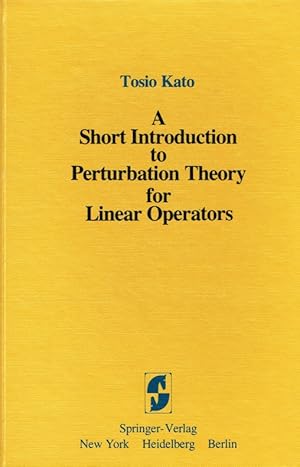short introduction perturbation theory von kato tosio (6 Ergebnisse)
Suchfilter
Produktart
- Alle Product Types
- Bücher (6)
- Magazine & Zeitschriften (Keine weiteren Ergebnisse entsprechen dieser Verfeinerung)
- Comics (Keine weiteren Ergebnisse entsprechen dieser Verfeinerung)
- Noten (Keine weiteren Ergebnisse entsprechen dieser Verfeinerung)
- Kunst, Grafik & Poster (Keine weiteren Ergebnisse entsprechen dieser Verfeinerung)
- Fotografien (Keine weiteren Ergebnisse entsprechen dieser Verfeinerung)
- Karten (Keine weiteren Ergebnisse entsprechen dieser Verfeinerung)
- Manuskripte & Papierantiquitäten (Keine weiteren Ergebnisse entsprechen dieser Verfeinerung)
Zustand Mehr dazu
- Neu (2)
- Wie Neu, Sehr Gut oder Gut Bis Sehr Gut (1)
- Gut oder Befriedigend (2)
- Ausreichend oder Schlecht (Keine weiteren Ergebnisse entsprechen dieser Verfeinerung)
- Wie beschrieben (1)
Einband
Weitere Eigenschaften
- Erstausgabe (Keine weiteren Ergebnisse entsprechen dieser Verfeinerung)
- Signiert (Keine weiteren Ergebnisse entsprechen dieser Verfeinerung)
- Schutzumschlag (Keine weiteren Ergebnisse entsprechen dieser Verfeinerung)
- Angebotsfoto (4)
Sprache (1)
Preis
- Beliebiger Preis
- Weniger als EUR 20 (Keine weiteren Ergebnisse entsprechen dieser Verfeinerung)
- EUR 20 bis EUR 45
- Mehr als EUR 45
Gratisversand
Land des Verkäufers
Verkäuferbewertung
-
A short introduction to perturbation theory for linear operators. Tosio Kato.
Verlag: New York, Springer, 1982
Sprache: Englisch
Anbieter: Antiquariat Bookfarm, Löbnitz, Deutschland
Hardcover. 161 S. Ehem. Bibliotheksexemplar mit Signatur und Stempel. GUTER Zustand, ein paar Gebrauchsspuren. Ex-library with stamp and library-signature. GOOD condition, some traces of use. Sprache: Englisch Gewicht in Gramm: 900.
-
A Short Introduction to Perturbation Theory for Linear Operators
Anbieter: Better World Books: West, Reno, NV, USA
Zustand: Good. Used book that is in clean, average condition without any missing pages.
-
A Short Introduction to Perturbation Theory for Linear Operators
Anbieter: Better World Books, Mishawaka, IN, USA
Zustand: Very Good. Former library book; may include library markings. Used book that is in excellent condition. May show signs of wear or have minor defects.
-
A Short Introduction to Perturbation Theory for Linear Operators.
Anbieter: Antiquariat Bernhardt, Kassel, Deutschland
Karton. Zustand: Sehr gut. Zust: Gutes Exemplar. 162 Seiten Englisch 432g.
-
A Short Introduction to Perturbation Theory for Linear Operators
Anbieter: preigu, Osnabrück, Deutschland
Taschenbuch. Zustand: Neu. A Short Introduction to Perturbation Theory for Linear Operators | Tosio Kato | Taschenbuch | xiv | Englisch | 2011 | Springer | EAN 9781461257028 | Verantwortliche Person für die EU: Springer Verlag GmbH, Tiergartenstr. 17, 69121 Heidelberg, juergen[dot]hartmann[at]springer[dot]com | Anbieter: preigu.
-
A Short Introduction to Perturbation Theory for Linear Operators
Verlag: Springer New York, Springer New York, 2011
ISBN 10: 1461257026 ISBN 13: 9781461257028
Sprache: Englisch
Anbieter: AHA-BUCH GmbH, Einbeck, Deutschland
Taschenbuch. Zustand: Neu. Druck auf Anfrage Neuware - Printed after ordering - This book is a slightly expanded reproduction of the first two chapters (plus Introduction) of my book Perturbation Theory tor Linear Operators, Grundlehren der mathematischen Wissenschaften 132, Springer 1980. Ever since, or even before, the publication of the latter, there have been suggestions about separating the first two chapters into a single volume. I have now agreed to follow the suggestions, hoping that it will make the book available to a wider audience. Those two chapters were intended from the outset to be a comprehen sive presentation of those parts of perturbation theory that can be treated without the topological complications of infinite-dimensional spaces. In fact, many essential and. even advanced results in the theory have non trivial contents in finite-dimensional spaces, although one should not forget that some parts of the theory, such as those pertaining to scatter ing. are peculiar to infinite dimensions. I hope that this book may also be used as an introduction to linear algebra. I believe that the analytic approach based on a systematic use of complex functions, by way of the resolvent theory, must have a strong appeal to students of analysis or applied mathematics, who are usually familiar with such analytic tools.






